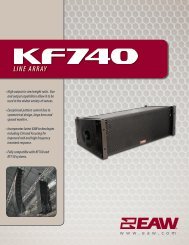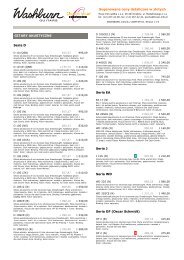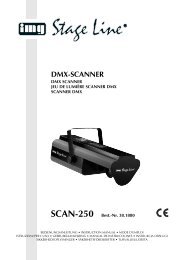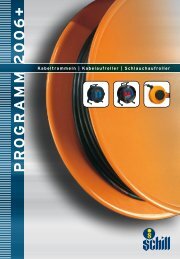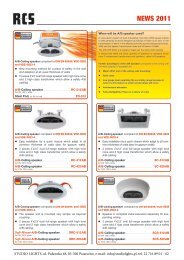Part - Studio Lights
Part - Studio Lights
Part - Studio Lights
Create successful ePaper yourself
Turn your PDF publications into a flip-book with our unique Google optimized e-Paper software.
KNOW-HOW 100 V PA TECHNOLOGY<br />
GENERAL INTRODUCTION INTO THE 100V PA TECHNOLOGY<br />
The following tips, explanations and illustrations are to approximate and facilitate the<br />
planning, configuration and subsequent service of 100V PA systems to you.<br />
As an introduction, we may state in many cases it is the 100V PA technology which<br />
makes a commercial acoustic irradiation principally possible, whereas it would be not at<br />
all, or only very hard and insufficiently possible, to implement effective systems with lowimpedance<br />
technology; this being popular first of all as entertainment electronics.<br />
In the following, we would like to give you some typical examples for the application of<br />
100V PA technology, which you will find again in the second part of this “guideline” supplemented<br />
by schematic drawings, circuit diagrams and explanations.<br />
●<br />
●<br />
●<br />
●<br />
●<br />
●<br />
●<br />
Sports fields and halls<br />
Open air and indoor baths<br />
Supermarkets and big stores<br />
Churches and chapels<br />
Car dealers and petrol stations<br />
Office and administration buildings<br />
Hotels and inns<br />
BASIC CHARACTERISTICS OF THE<br />
100V PA TECHNOLOGY<br />
It is important and basic to realize that 100V PA systems are<br />
practically always built in “Mono”.<br />
This is no issue of quality, as a mono signal is not worse than<br />
a stereo signal. But, in order to use a stereo signal expediently,<br />
2 loudspeakers and 2 power amplifiers have to be<br />
supplied, and furthermore the listeners have to be in the proper<br />
position and distance to the speakers – and also stay<br />
that way. Needless to say that this is impossible, especially<br />
when you look at the above mentioned application examples.<br />
Naturally, a horn speaker does not have the same transmission<br />
quality as a Pro-Sound speaker. This does not at all<br />
deal with the approach mono against stereo, but solely with<br />
the situation of application which differs from case to case.<br />
Referring to 100V transformers:<br />
A modern 100V transformer is easily able to achieve a frequency<br />
response of 50 – 20,000 Hz which is fully sufficient<br />
for top quality acoustic irradiation. However, in practice such<br />
a frequency response is normally not required for commercial<br />
PA systems.<br />
Normally, a 100V PA system consists of three parts, which<br />
are:<br />
– Microphone or microphone station<br />
– Amplifier with components<br />
– Loudspeaker<br />
The signal sent to the amplifier by either a microphone or a<br />
similar device, is edited by the amplifier and its component<br />
units and finally provided at the outputs. There, the signal is<br />
changed to 100V by a transformer which is normally installed<br />
in the amplifier.<br />
There is also a 100V transformer embedded in the loudspeaker,<br />
which changes the incoming signal again to the appropriate<br />
impedance for the particular speaker frame (usually 4,<br />
8 or 16 ohms).<br />
Since the number of required loudspeakers for PA systems<br />
is normally high or very high, the 100V technology can show<br />
all its strength in wiring as well as in the desired allocation of<br />
signals.<br />
290



